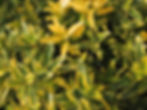There are countless species of trees and shrubs that can be clipped and trained to form a hedge or hedgerow: most of what we are exposed to are larger species and varieties that tend towards forming larger hedges. That’s fine, as long as we want to create larger hedges, that might create shelter, define spaces, or block views; but if we want to simply frame beds and borders or create low hedges inside our gardens, selecting the correct plant for the job is essential for success. In 2017 RHS Wisley created a new mixed species Knot Garden using a number of smaller growing, or slower growing and clippable species to avoid using Buxus (Box) in light of issues with Box Moth and Box Blight. The new know contains species and cultivars of Lonicera, Podocarpus, Pittosporum, Berberis, Cotoneaster and Taxus, to name a few. A good idea this and worth a visit if you are at Wisley. The picture below is from November 2022 and shows some of the colour and textural differences of the plant material selected. Here is a link for more info on this area of Wisley Gardens. We will likely see more of these experiments going forward and we are all the better for them.

Here are my Top 5 evergreen shrubs for making into a low hedge.
For clarity, I’m suggesting that a low hedge is between 30cm (1’) tall, up to 1.2m (4’) tall.

Buxus microphylla ‘Faulkner’ - Roundleaved Box
In recent years across the UK, Box Blight and now Box Moth Caterpillar have become huge problems in harming Box plants. Though the problem is still focused on Southern England, it is steadily on the move North and will likely be endemic to all of the UK with next 20 years. Though we can treat against both issues, they require extensive chemical use and are often only partly successful. Thus, Buxus sempervirens (Common Box) has been removed as an option for a great many gardeners. Where it was a hugely popular small hedging material throughout the UK, it is being used less and less as gardeners seek less troubled alternatives. Ilex crenata (Japanese Holly) has been suggested and used by a lot of designers as a replacement, but I find it a bit irregular in habit, with a tendency to drop a lot of leaves in autumn and spring. Personally, I’m yet to see an Ilex crenata hedge that I actually liked, but it is an option. Buxus microphylla has been proven to be more resilient to Box Blight (which is a fungal condition spread through soil and water, which causes dieback and ultimately death). Resilience to Box Blight is not the same immunity, but I have not seen plants of B. microphylla affected by it. The variety ‘Faulkner’ is the most commonly seen form and it has larger (ironic because the species name of microphylla means small leaves), more rounded leaves than B. sempervirens, in a darker shade of glossy green. It is hardy throughout the UK and grows in sun or shade in any fertile soil providing it is not waterlogged. Ultimately, it can get large to over 3m (10’) if left to grow, but clipped two or three times a year, plants can easily be kept to 60cm (2’) - 1.2m (4’). Also an excellent choice for topiary shapes like Cones or Balls.

Euonymus japonicus ‘Microphyllus Pulchellus’ - Small leaved Japanese Spindle
There are a number of naturally upright growing forms of Euonymus japonicus, with a variety of leaf sizes and colours. This is a very small-leaved, yellow variegated form; if you prefer green leaved, you can go for E. j. ‘Microphyllus’ for a small- leaved form, or E. j. ‘Jean Hugues’ for a larger-leaved and larger growing option. Worth having a look around for your favourite form. I like the form ‘Microphyllus Pulchellus’ as it can be shaped to make a very small hedge to 30cm (1’) tall or less and remains dense and compact with minimal clipping and has a bright, yellow-variegated foliage around 2cm (25/32nd") long and 0.5cm (13/64th") wide. Happy in sun or part-shade, but I’d probably avoid planting it where early morning sun could scorch dewy leaves. As it is a naturally very small plant, you should think about the size that you. It at and tiny plants will take some time to settle, establish and grow to make a hedge.

Lonicera ligustrina var. yunnanensis ‘Baggesen’s Gold’ (Syn. L. nitida ‘Baggesen’s Gold’) - Yellow Shrubby/Wilson’s Honeysuckle
There are now lots of shrubby honeysuckles, available, with both evergreen and deciduous species and cultivars available. Most of the deciduous species have handsome flowers, often with good scent. Although the evergreen forms do flower, it is small and generally not very exciting. Forms of Lonicera nitida (I’m using this name as it is the one most commonly found) (Japanese/Wilson’s shrubby Honeysuckle) have small leaves, often no bigger than a pinky fingernail. Most are pale-green in colour, but ‘Baggesen’s Gold’ is distinctly golden yellow, especially after prolonged periods of sun. Despite being woody in nature, the growth can be a bit lax and hedges, although clippable to very precise forms, tend to wobble a little and taller hedges can be a bit wavy because of this. If you allow the hedge to be as wide as it is tall and keep it at 1.2m (4’) max tall, it is usually pretty stable. Probably best at around 90cm (3’) tall and at least 60cm (2’) wide. Does have a tendency to drop some leaves in autumn, especially in exposed sites. I like the red flush to leaves in spring and autumn.

Photinia x fraseri ‘Little Red Robin’ - Small-leaved Photinia
For many years we saw Photinia ‘Red Robin’ everywhere and it can make a good evergreen hedge up to 2.5m (8’) tall. While it is still readily available, it’s rate of growth it too much for a low hedge. About 10 years ago, the variety ‘Little Red Robin’ burst onto the scene and its compact habit and significantly smaller leaf makes for a much more favourable small hedging plant. Mature leaves are dark, glossy green, with young foliage a bright red. ‘Little Red Robin’ has a naturally quite rounded habit, so can be grown as a ball shape with ease as well. Easy enough to grow around the UK, providing it is not planted in spots exposed to cold winds, or with its roots in wet or waterlogged soil. Instead, fertile soil, which is moist, but well drained (a classic soil cultivation recommendation that seems to contradict itself) and a sunny spot is essential for success. Grows surprisingly well in chalky soils, though it can be a little more open in habit. I’d recommend this for a hedge of 45-60cm (18” - 2’) tall. It can easily enough get taller, but takes a while.

Salvia rosmarinus ‘Gorizia’ (Syn. Rosmarinus officinalis ‘Gorizia’) - Giant Rosemary
Rosemary is an eternally popular garden plant in the UK and any upright growing variety will work as a hedging plant. The most commonly available variety is probably ‘Miss Jessop’s Upright’, but I prefer the largest growing variety of Rosemary available - ‘Gorizia’. Less easy to get hold of, but because of its size (up to 1.8m (6’) tall) it will grow a bit quicker than most and be evenly dense in shape, which can be a problem with growing Rosemary as a hedging plant. Small, aromatic leaves that can be used in cooking, like other varieties. Grow in full sun; the more the merrier here. Well-drained soil is also essential and given an optimal position it makes a great garden plant, or clips to a hedge at around 60cm - 1.2m (2’ - 4’) tall. Worth seeking out this form, especially if you want your hedge to be on the taller side. Rosemary flower almost all year round and are one of the few plants I can rely on being in flower on Christmas Day each year when I tend to do a little audit of flowering plants in the iPlantsgarden. Small, intricate, pales blue flowers are worth close inspection. As ornate as an orchid flower, they all too often get overlooked.
A few suggestions on resource to help you create and maintain excellent hedges.
I trialled these Fiskars Shears previously and found them to be sharp, comfortable to hold, light in weight and easy to use.
Old school shearing... could be a sheep or a hedge. I've always actually enjoyed using these to clip topiary and small hedges as you have a lot of control.
Great Kit from WORX for small hedges and topiary pruning.
Feeling confident or a larger area to cover, try these excellent WORX Cordless Hedge Trimmers!

Please note, any links to purchase product on this page are paid affiliate link. If you purchase an item, using any of these links I will receive a small payment from them. It doesn't cost you anything and the item is priced as per the normal website price. You can read our affiliate policy here. Links to other websites for information purposes do not benefit me financially and are meant to be informative. I accept no responsibility for the quality, accuracy, or content from third party sites. Thanks
Please note, Images on this page are my own, or labelled with permission from the author/publisher. As with all images on this site, they are not for reproduction or use without written permission. Permissions can be sought from emailing hello@iplantsman.com though images of materials copywritten or owned by another party will not be given.
#hedge #edges #hedgerows #lowhedge #Salvia #Rosmarinus #Salviarosmarinus #Rosmarinusofficinalis #SalviarosmarinusGorizia #RosmarinusofficinalisGorizia #Lonicera #LoniceranitidaBaggesensGold #LoniceraBaggesensGold #ShrubbyHoneysuckle #Honeysuckle #Rosemary #Photinia #PhotiniaLittleRedRobin #PhotiniaxfraseriLittleRedRobin #Euonymus #Spindle #JapaneseSpindle #EuonymusjaponicusMicrophyllusPulchellus #Euonymusjaponicus #EuonymusjaponicusMicrophyllus #Buxus #Box #BoxBlight #BoxMoth #BoxMothCaterpillar #Caterpillar #PestandDisease #iplantsman #iplantsgarden #Buxussempervirens #Buxusmicrophylla #BuxusFaulkner #BuxusmicrophyllaFaulkner #RHSWisley #RHSGardens #RHSWisleyGardens #Knot #KnotGarden #Topiary #Pruning #PlantTraining #Plantshaping #Top5 #iplantsmantop5 #top5evergreenshrubs #evergreenshrubs
